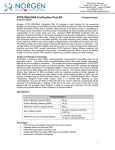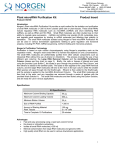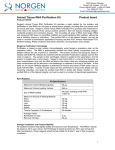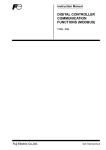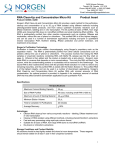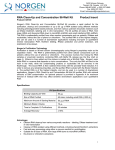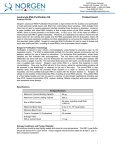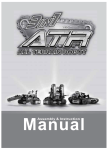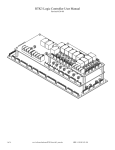Download Preserved Blood RNA Purification Kit II Product Insert (for use with
Transcript
3430 Schmon Parkway Thorold, ON, Canada L2V 4Y6 Phone: 866-667-4362 (905) 227-8848 Fax: (905) 227-1061 Email: [email protected] Preserved Blood RNA Purification Kit II (for use with PAXgene™ Blood RNA Tubes) Product Insert Product # 43500 Norgen’s Preserved Blood RNA Purification Kit II provides a rapid method for the isolation and purification of total RNA from blood that has been preserved using PAXgene™ Blood RNA Tubes*. The kit purifies all sizes of RNA, from large mRNA and ribosomal RNA down to microRNA (miRNA) and small interfering RNA (siRNA). The RNA is preferentially purified from other cellular components such as proteins, without the use of phenol or chloroform. The purified RNA is of the highest integrity, and can be used in a number of downstream applications including real time PCR, reverse transcription PCR, Northern blotting, RNase protection and primer extension, and expression array assays. Norgen’s Purification Technology Purification is based on spin column chromatography using Norgen’s proprietary resin as the separation matrix. The RNA is preferentially purified from other cellular components such as proteins without the use of phenol or chloroform. The process first involves pelleting the cells and washing them in NPX1 Solution. Next, NPX2 is added to the sample in order to lyse the cells, then ethanol is then added to the lysate and the solution is loaded onto a spin-column. Norgen’s resin binds RNA in a manner that depends on ionic concentrations. Thus only the RNA will bind to the column, while the contaminating proteins will be removed in the flowthrough or retained on the top of the resin. The bound RNA is then washed once using the provided NPX3 solution, and then DNase I treatment is carried out using the provided DNase I and NPX4 solution. The RNA is then washed 2 additional times using NPX3 in order to remove any remaining impurities, and the purified total RNA is eluted with NPX5 solution. The purified RNA is of the highest integrity, and can be used in a number of downstream applications. Specifications Kit Specifications Maximum Column Binding Capacity 50 g Maximum Column Loading Volume 650 L Size of RNA Purified All sizes, including small RNA (<200 nt) Time to Complete 10 Purifications 30 minutes Average Yield 5 – 20 g per 2.5 mL preserved human blood Advantages Fast and easy processing of preserved blood using rapid spin-column format Isolate total RNA, from large rRNA down to microRNA (miRNA) No phenol or chloroform extractions Isolate high quality total RNA Storage Conditions and Product Stability o The DNase I should be stored at -20 C. All other solutions should be kept tightly sealed and stored at room temperature. These reagents should remain stable for at least 1 year in their unopened containers. * PAXgene™ is a registered trademark of PreAnalytiX GmbH 1 Kit Components Component NPX1 NPX2 NPX3 NPX4 NPX5 DNase I Mini Spin Columns Collection Tubes Elution tubes (1.7 mL) Product Insert Product # 43500 (50 preps) 2 x 110 40 mL 22 mL 6 mL 6 mL 1 vial 50 50 50 1 Precautions and Disclaimers This kit is designed for research purposes only. It is not intended for diagnostic use. Ensure that a suitable lab coat, disposable gloves and protective goggles are worn when working with chemicals. For more information, please consult the appropriate Material Safety Data Sheets (MSDSs). These are available as convenient PDF files online at www.norgenbiotek.com. Blood of all human and animal subjects is considered potentially infectious. All necessary precautions recommended by the appropriate authorities in the country of use should be taken when working with whole blood. The NPX2 Solution contains guanidinium salts, and should be handled with care. Guanidinium salts form highly reactive compounds when combined with bleach, thus care must be taken to properly dispose of any of these solutions. Customer-Supplied Reagents and Equipment You must have the following in order to use Norgen’s Preserved Blood RNA Purification Kit II: Benchtop microcentrifuge Swing bucket centrifuge 50 mL conical tubes 96 - 100% ethanol Working with RNA RNases are very stable and robust enzymes that degrade RNA. Autoclaving solutions and glassware is not always sufficient to actively remove these enzymes. The first step when preparing to work with RNA is to create an RNase-free environment. The following precautions are recommended as your best defense against these enzymes. The RNA area should be located away from microbiological work stations Clean, disposable gloves should be worn at all times when handling reagents, samples, pipettes, disposable tubes, etc. It is recommended that gloves are changed frequently to avoid contamination There should be designated solutions, tips, tubes, lab coats, pipettes, etc. for RNA only All RNA solutions should be prepared using at least 0.05% DEPC-treated autoclaved water or molecular biology grade nuclease-free water Clean all surfaces with commercially available RNase decontamination solutions When working with purified RNA samples, ensure that they remain on ice during downstream applications 2 Flowchart Procedure for Purifying Total RNA from Preserved Blood using Norgen’s Preserved Blood RNA Purification Kit II (for use with PAXgene™ Blood RNA Tubes) Pellet cells from preserved blood sample. Wash with NPX1. SPIN Discard supernatant. Add NPX2 SPIN Transfer supernatant. Add ethanol. Bind to column SPIN Wash once with NPX3. Perform DNase I treatment using NPX4. Wash twice with NPX3. SPIN Elute RNA with NPX5 SPIN Purified Total RNA 3 Procedures All centrifugation steps are carried out in a benchtop microcentrifuge. Various speeds are required for different steps, so please check your microcentrifuge specifications to ensure that it is capable of the proper speeds. All centrifugation steps are performed at room temperature. The correct rpm can be calculated using the formula: RPM = RCF (1.118 x 10-5) (r) where RCF = required gravitational acceleration (relative centrifugal force in units of g); r = radius of the rotor in cm; and RPM = the number of revolutions per minute required to achieve the necessary g-force. Notes Prior to Use Refer to manufacturer’s product documentation for specific instructions on venipuncture technique, blood collection, storage and shipment conditions and safety information. All centrifugation steps are carried out in a benchtop microcentrifuge at 14,000 x g (~ 14,000 RPM) except where noted. All centrifugation steps are performed at room temperature. A variable speed centrifuge should be used for maximum kit performance. If a variable speed centrifuge is not available a fixed speed centrifuge can be used, however reduced yields may be observed. Ensure that all solutions are at room temperature prior to use. Prepare a working concentration of the NPX3 by adding 50 mL of 95% ethanol (provided by the user) to the supplied bottle containing the concentrated NPX3. This will give a final volume of 72 mL. The label on the bottle has a box that may be checked to indicate that the ethanol has been added. It is important to work quickly during this procedure. Blood of all human and animal subjects is considered potentially infectious. All necessary precautions recommended by the appropriate authorities in the country of use should be taken when working with whole blood. 1. Lysate Preparation from PAXgene™ Blood RNA Tubes 1. Lysate Preparation from PAXgene™ Blood RNA Tubes a. Centrifuge the PAXgene™ Tube for 10 minutes at 3,000–5,000 x g using a Beckman JB6 or equivalent swing bucket centrifuge. b. Discard supernatant. Add 4 mL of NPX1 to the pellet. c. Vortex until the pellet is visibly dissolved. Centrifuge the PAXgene™ Tube for 10 minutes at 3000–5000 x g using a Beckman JB-6 or equivalent swing bucket centrifuge. d. Discard supernatant. Add 600 L of NPX2 to the pellet. Vortex to dissolve the pellet. e. Centrifuge the lysate at 14,000 x g (~ 14,000 RPM) for 1 minute to remove any insoluble materials. Transfer the supernatant to a new RNase-free microcentrifuge tube. f. Add 300 L of 95-100% ethanol (provided by the user). Vortex to mix. g. Proceed to “Step 2:Binding RNA to Column”. 2. Binding RNA to Column a. Assemble a column with one of the provided collection tubes. b. Apply up to 600 L of the lysate with the ethanol (from Step 1) onto the column and centrifuge for 1 minute at ≥ 3,500 x g (~6,000 RPM). 4 Note: Ensure the entire lysate volume has passed through into the collection tube by inspecting the column. If the entire lysate volume has not passed, spin for an additional minute at 14,000 x g (~14,000 RPM). c. Discard the flowthrough. Reassemble the spin column with its collection tube. d. Depending on your lysate volume, repeat Step 2b and 2c as necessary. 3. Column Wash a. Apply 400 L of NPX3 to the column and centrifuge for 1 minute. Note: Ensure the entire wash solution has passed through into the collection tube by inspecting the column. If the entire wash volume has not passed, spin for an additional minute. b. Discard the flowthrough and reassemble the spin column with its collection tube. c. For every on-column DNase I reaction to be performed, prepare a mix of 15 L of DNase I and 100 µL of NPX4. Mix gently by inverting the tube a few times. DO NOT VORTEX. Note: DNase I treatment is highly recommended. If DNase I treatment is not required, proceed to Step 3g directly. d. Apply DNase I solution mix prepared in Step 3c to the column and centrifuge at 14, 000 x g (~14 000 RPM) for 1 minute. Note: Ensure that the entire DNase I solution passes through the column. If needed, spin at 14, 000 x g (~14 000 RPM) for an additional minute. e. After the centrifugation in Step 3d, pipette the flowthrough that is present in the collection tube back onto the top of the column. Note: Ensure this step is performed in order to ensure maximum DNase activity and to obtain maximum yields of RNA, in particular for small RNA species. o f. Incubate the column assembly at 25 - 30 C for 15 minutes. g. Without any further centrifugation, apply 400 L of NPX3 to the column and centrifuge for 1 minute. Note: Apply NPX3 directly to the column containing the DNase mix. Ensure the entire wash solution has passed through into the collection tube by inspecting the column. If the entire wash volume has not passed, spin for an additional minute. h. Discard the flowthrough and reassemble the spin column with its collection tube. i. Wash column a third time by adding another 400 L of NPX3 and centrifuging for 1 minute. j. Discard the flowthrough and reassemble the spin column with its collection tube. k. Spin the column for 2 minutes in order to thoroughly dry the resin. Discard the collection tube. 4. RNA Elution a. Place the column into a fresh 1.7 mL Elution tube provided with the kit. b. Add 50 L of NPX5 to the column. 5 c. Centrifuge for 2 minutes at 200 x g (~2,000 RPM), followed by 1 minute at 14,000 x g (~14,000 RPM) Note the volume eluted from the column. If the entire 50 L has not been eluted, spin the column at 14,000 x g (~14,000 RPM) for 1 additional minute. Note: For maximum RNA recovery, it is recommended that a second elution be performed into a separate microcentrifuge tube (Repeat Steps 4b and 4c). 5. Storage of RNA The purified RNA sample may be stored at –20°C for a few days. It is recommended that samples be placed at –70°C for long term storage. Troubleshooting Guide Problem Poor RNA Recovery Possible Cause Solution and Explanation Incomplete lysis of blood Ensure that the appropriate amount of NPX2 was used. An alternative elution solution was used It is recommended that the NPX5 Solution supplied with this kit be used for maximum RNA recovery. Ethanol was not added to the lysate Ensure that the appropriate amount of ethanol is added to the lysate before binding to the column. Ethanol was not added to NPX3 Ensure that 50 mL of 96-100% ethanol is added to the supplied NXP3 prior to use. Insufficient centrifugation time and speed when pelleting the stabilized blood RNA before addition of NPX2 for Lysis Centrifuge the PAXgene™ Tube for 10 minutes at 3,000–5,000 x g Low RNA Content in Sample Amount of cellular RNA could vary drastically in different individuals. In particular, blood from healthy individuals with low white blood cell count is expected to have lower RNA yield Insufficient solubilization of blood Ensure that the appropriate amount of NPX1 and NPX2 was used. Centrifuge temperature too low Ensure that the centrifuge remains at room temperature throughout the procedure. Temperatures below 15°C may cause precipitates to form that can cause the columns to clog. Clogged Column 6 Problem RNA is Degraded RNA does not perform well in downstream applications Genomic DNA contamination Possible Cause Solution and Explanation RNase contamination RNases may be introduced during the use of the kit. Ensure proper procedures are followed when working with RNA. Please refer to “Working with RNA” at the beginning of this user guide. Procedure not performed quickly enough In order to maintain the integrity of the RNA, it is important that the procedure be performed quickly. Improper storage of the purified RNA For short term storage RNA samples may be stored at –20°C for a few days. It is recommended that samples be stored at –70°C for longer term storage. RNA was not washed 3 times with NPX3 Traces of salt from the binding step may remain in the sample if the column is not washed 3 times with NXP3. Salt may interfere with downstream applications, and thus must be washed from the column. Ethanol carryover Ensure that the dry spin under the Column Wash procedure is performed, in order to remove traces of ethanol prior to elution. Ethanol is known to interfere with many downstream applications. Large amounts of starting material used Perform the DNaseI digestion on the RNA sample prior to elution using the provided DNase I solution and NPX4 solution. Related Products TM Preserved Blood RNA Purification Kit I (for use with Tempus Blood RNA Tubes) RNase-Free DNase I Kit Total RNA Purification Kit RNA/Protein Purification Kit RNA/DNA/Protein Purification Kit Cytoplasmic & Nuclear RNA Purification Kit Leukocyte RNA Purification Kit microRNA Purification Kit 100b RNA Ladder 1kb RNA Ladder Product # 43400 25710 17200 23000 23500 21000 21200 21300 15002 15003 7 Technical Support Contact our Technical Support Team between the hours of 8:30 and 5:30 (Eastern Standard Time) at (905) 227-8848 or Toll Free at 1-866-667-4362. Technical support can also be obtained from our website (www.norgenbiotek.com) or through email at [email protected]. 3430 Schmon Parkway, Thorold, ON Canada L2V 4Y6 Phone: (905) 227-8848 Fax: (905) 227-1061 Toll Free in North America: 1-866-667-4362 ©2015 Norgen Biotek Corp. PI43500-3 8









